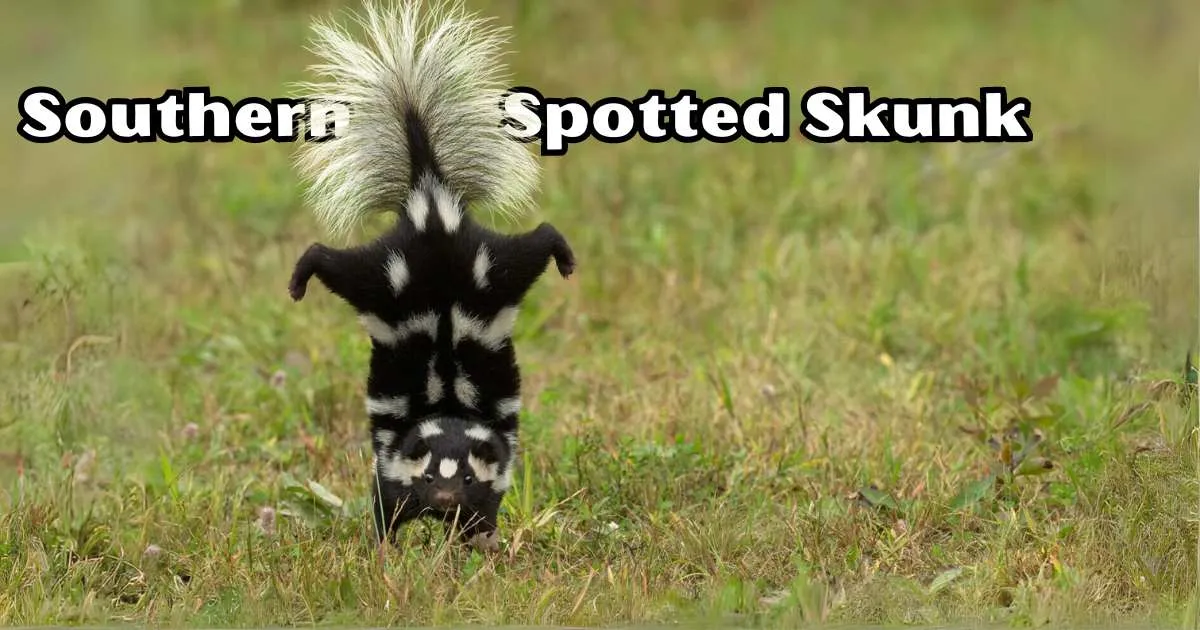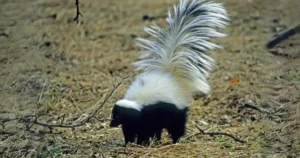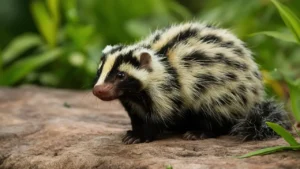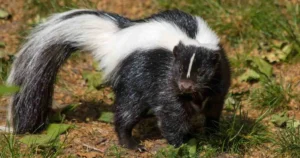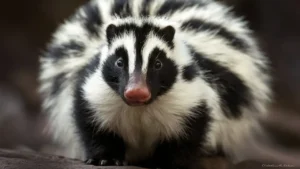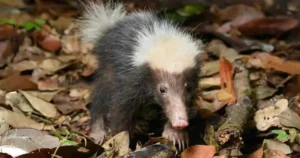Southern Spotted Skunk: Behavior, Diet, & Key Facts
Ever seen a skunk with spots? It’s a thing! They’re called Southern Spotted Skunks, and they’re kinda like the ninjas of the forest. They sneak around at night, mostly by themselves, munching on bugs, small critters, and even fruit (who knew?). They can climb, they can hide, and if they get really scared, watch out! They’ve got a super stinky superpower. These little dudes are pretty cool, and knowing about them helps us understand how they keep nature running smoothly.
Introduction To The Southern Spotted Skunk
Dive into the secretive life of the Southern Spotted Skunk. This small, elusive creature thrives in the diverse habitats of the southern United States. With night-time activities and distinctive markings, it captures curiosity. The Southern Spotted Skunk boasts a unique adaptability in the wild.
The Skunk’s Unique Place In The Animal Kingdom
As a member of the Mephitidae family, the Southern Spotted Skunk holds a special status among nocturnal predators. Its famous defense mechanism of spraying a pungent odor keeps foes at bay. It sports characteristic white spots and broken stripes over black fur.
| Southern Spotted Skunk Quick Facts | |
| Size: | 13-18 inches |
| Weight: | 1-2.5 pounds |
| Lifespan: | Up to 5 years in the wild |
| Defense: | Sprays foul odor |
The Significance Of Studying Skunks
Understanding skunks helps us appreciate ecological balance. These animals control pests and reflect environmental health. By studying their habits and needs, we can aid conservation efforts. Their behaviors provide insights into survival adaptations in mammals.
- Control insect and rodent populations
- Indicators of Ecological Change
- Help shape conservation strategies
Physical Characteristics
Discover the unique traits of the Southern Spotted Skunk. Noticeable for its striking patterns and agility, this creature’s appearance is as fascinating as its behavior.
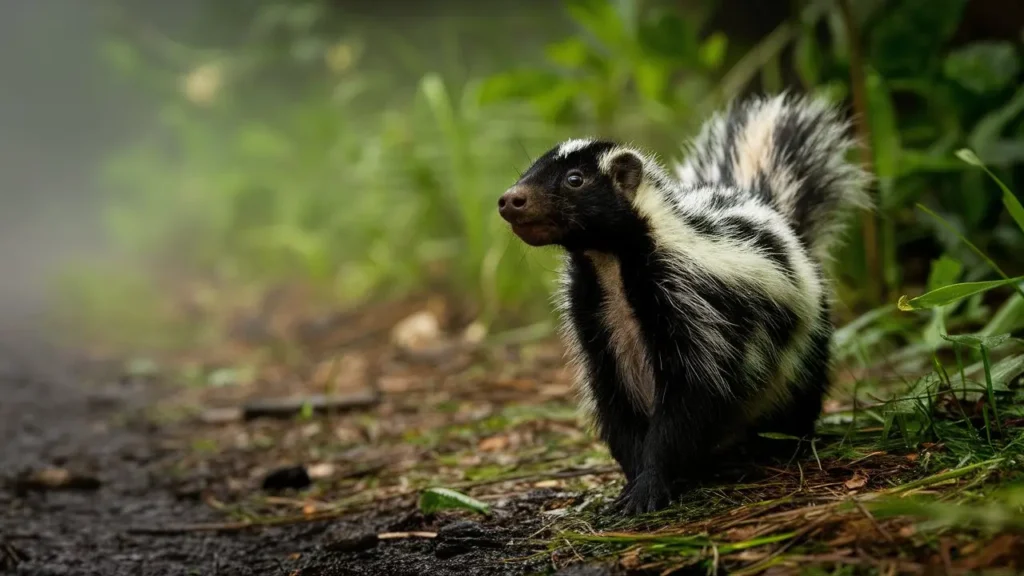
Size And Appearance
Compact and nimble, the Southern Spotted Skunk boasts a slender build. Adults typically weigh between 0.5 to 1.5 kilograms (1.1 to 3.3 pounds). From nose to tail, they measure around 40 to 60 centimeters (15.7 to 23.6 inches). Short legs and a long bushy tail distinguish it from other species.
Pattern And Fur Variations
Their striking fur sets them apart. Each skunk has a unique pattern, much like human fingerprints. The standard color is jet black with variable white spots and stripes. This helps them to blend in the shadows of the night.
These fur patterns are not just for show—they play a crucial role in communication and survival.
| Feature | Description |
|---|---|
| Size | 40-60 cm long, 0.5-1.5 kg in weight |
| Appearance | Slender, short legs, long tail |
| Fur Pattern | Black with white spots/stripes |
Habitats And Distribution
Exploring the ‘Habitats and Distribution’ of the Southern Spotted Skunk offers insights into the life of this elusive creature. Unraveling where they roam and thrive unveils the integral parts of their existence.
Geographic Range
The Southern Spotted Skunk has a vast geographic range. They inhabit regions across the United States, Mexico, and Central America. Key locations include Missouri, Arkansas, and eastern Texas in the USA.
Preferred Environments
These skunks are not just adaptable, but selective too. They favor environments that provide ample cover and food sources. Listed below are their preferred habitats:
- Dense forests – for hiding and hunting.
- Woodland edges – offering diverse food varieties.
- Grassy clearings – ideal for insect prey.
- Agricultural fields – with plenty of rodents and crops.
Understanding their habitats and distribution helps us to appreciate and protect the existence of the Southern Spotted Skunk.
Dietary Habits
The Southern Spotted Skunk is a small, elusive carnivore with a diverse menu. Adaptable eaters, these skunks change their diets with the seasons. Understanding what fuels these creatures is vital to appreciating their role in the ecosystem.
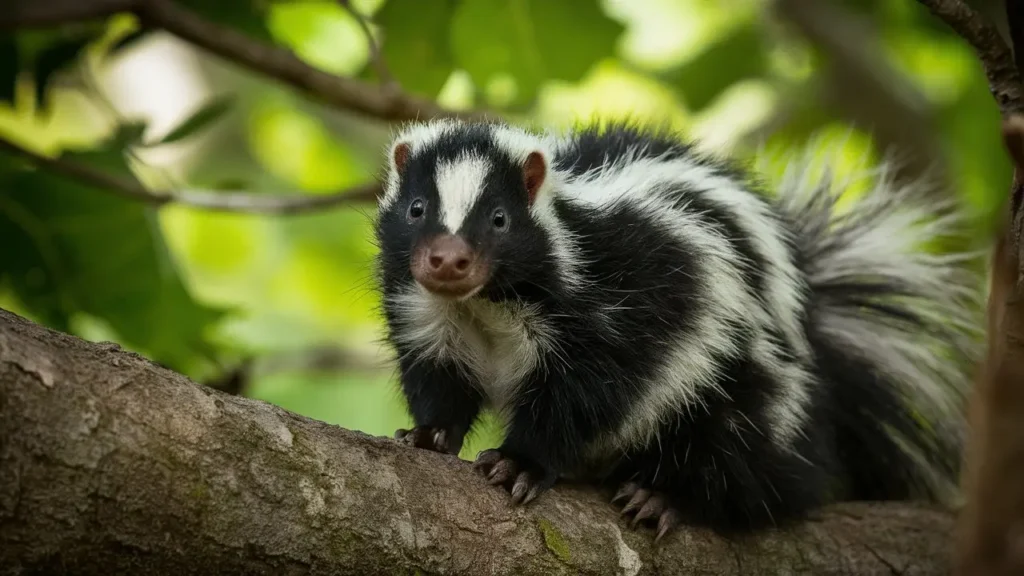
Typical Food Intake
Spotted Skunks have a varied diet. Outlined below is what they commonly consume:
- Insects are high in protein and are a staple food source.
- Small Mammals – Including rodents, providing essential fats.
- Birds – Occasional prey, for variety in nutrition.
- Fruits and Berries – For natural sugars and fiber.
- Eggs – Both birds and reptiles are a rich nutrient source.
Foraging Techniques
Skunks employ several strategies to find food:
| Technique | Description |
|---|---|
| Digging | Using sharp claws to unearth insects and larvae. |
| Climbing | Scaling trees to reach nests for eggs or birds. |
| Pouncing | Surprise attacks on small rodents or birds on the ground. |
| Scavenging | Feeding on carcasses when other food is scarce. |
The skunk’s flexible diet and smart foraging help it to thrive in various habitats.
Behavioral Patterns
The Southern Spotted Skunk, a fascinating creature, displays unique behaviors in the wild. Understanding these behaviors provides insights into their survival strategies and social habits.
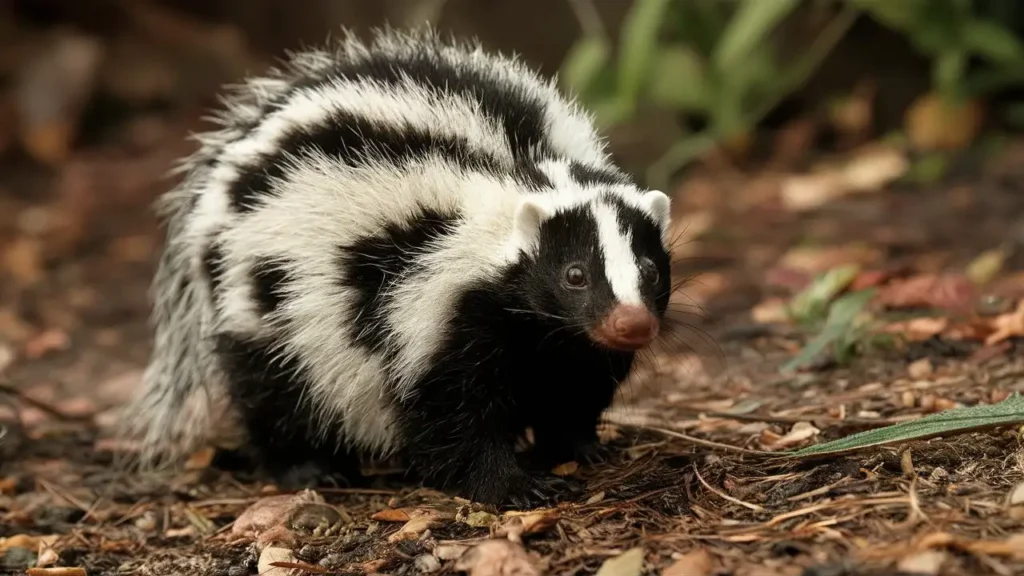
Social Interaction
These skunks are solitary, venturing out mostly at night. They only come together during mating season. Young skunks stay with their mother until they can fend for themselves. This period of dependence is crucial as they learn essential survival skills.
Defensive Mechanisms
The Southern Spotted Skunk is well-known for its impressive defensive tactics.
- When threatened, it performs a handstand to display its warning colors.
- If a predator persists, the skunk sprays a foul odor.
- The spray can reach up to 15 feet and is very accurate.
- A last resort, their spray is potent and can deter most threats.
Reproduction And Lifecycle
The southern spotted skunk, a creature of mystery and agility, follows intriguing patterns in its reproduction and lifecycle. The species exhibits distinct behaviors during mating and raises its young with care. Understanding these phases is key to grasping the life of these elusive skunks.
Mating Rituals
Intense and competitive, the mating rituals of the southern spotted skunk are a wonder of nature:
- Males travel long distances to find a mate.
- Late winter to early spring marks the peak of mating season.
- Stomping dances and scents are part of the courtship.
- Once a pair forms, the bond is only temporary for mating.
Development Of Young
The growth of southern spotted skunk offspring is a rapid journey from birth to independence:
- Gestation lasts roughly 50 to 65 days.
- Litters range from 2 to 10 kits, with a common size of 5 to 6.
- Kits are born blind and helpless but grow quickly.
- By 4 weeks, they begin to see; weaning occurs at 8 weeks.
- Full maturity is reached by 10 to 12 months of age.
- By fall, young skunks disperse to establish their territories.
Conservation Status
The Southern Spotted Skunk, a small and elusive creature of the night, faces various threats requiring attention for its survival. Understanding its Conservation Status is essential to ensure this skunk doesn’t become a ghost of the woodlands. Here we dive into the details.
Population Threats
Despite their adaptability, Southern Spotted Skunks are not immune to risk. Chief threats include:
- Habitat destruction due to urbanization and agriculture.
- Predation from larger mammals and birds of prey.
- Accidental deaths from road traffic and pest control measures.
- Diseases such as rabies and canine distemper.
Conservation Efforts
To combat these threats, diverse Conservation Efforts are in place:
- Legal protection of habitats through wildlife reserves.
- Research initiatives to better understand their ecology and behavior.
- Community outreach programs to raise awareness about the species.
Collaboration between government entities, conservation organizations, and the public is crucial for the skunk’s future.
Interesting Analogies And Cultural Impact
The Southern Spotted Skunk, with its intriguing behavior and diet, often leaps from the shadows of the wild into the bright lights of human culture. This creature’s impact stretches far beyond forested areas and into the hearts and stories of people. Let’s explore how these black-and-white marvels have skunked their way into folklore and sparked interest in research and education.
Skunks In Folklore And Mythology
The spotted skunk often appears in tales spun long ago. Tribes like the Apache have rich stories where the skunk plays clever tricks. In folklore, skunks symbolize various traits from courage to cunning.
- ‘The Brave Skunk’: a story where skunks outwit enemies.
- ‘Skunk’s Fumy Gift’: explains why they spray when scared.
Research And Education
Biologists dedicate much time to studying these creatures. Their diets primarily consist of insects and small mammals. Their nocturnal and elusive nature makes them challenging research subjects.
| Study Aspect | Fact |
|---|---|
| Diet | Insects, small mammals, fruits |
| Behavior | Nocturnal, solitary, spray defense |
Educational programs use these facts to teach about wildlife conservation. Seeing the skunk as more than a smelly nuisance, but a vital part of ecosystems can inspire this change.
Frequently Asked Questions
Southern spotted skunks primarily eat insects, small mammals, birds, eggs, fruits, and vegetation. Their diet is varied and adaptable.
Skunks inhabit woodlands, grasslands, and suburban areas, favoring mixed landscapes with shelters. They are nocturnal creatures, displaying solitary behavior except during mating season, often spraying a foul scent as a defense.
Skunks are known for their defensive spray, a strong-smelling secretion. North America is home to most skunk species. They are omnivores, eating both plants and animals. Skunks have poor eyesight but a keen sense of smell. The breeding season for skunks is usually in spring.
Conclusion
Understanding the Southern Spotted Skunk reveals a world of fascinating behaviors and dietary habits. This elusive creature plays a unique role in its ecosystem. The skunk captivates those passionate about wildlife with its distinct patterns and nocturnal antics. Embrace the intrigue these animals offer by continuing to learn and share their story.

